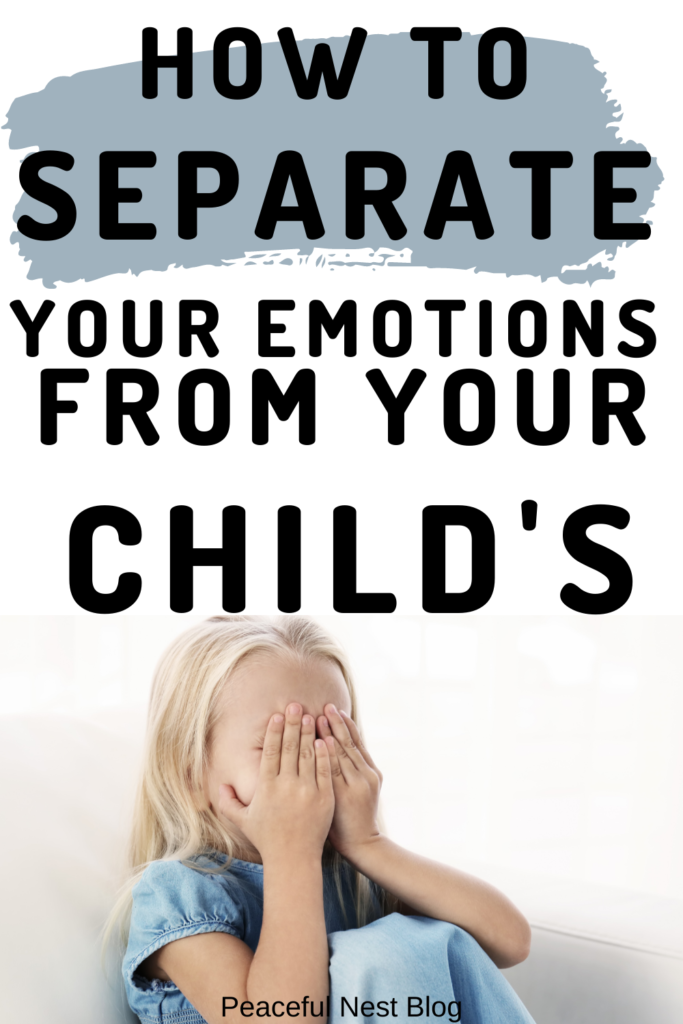As a mom, it’s essential to separate your emotions from your child’s emotions.
When our emotions get mixed with our child’s feelings, it can be challenging to handle them productively. Kids will have tantrums and emotional meltdowns – it’s part of their development. But, we want them to learn how to regulate their emotions so that they don’t cause long-term damage. Here are some tips on how to do that.
Why do we need to learn to separate our emotions from our child’s emotions?
It’s essential to separate your emotions from your child’s emotions for a few reasons. First, when our feelings are mixed with our child’s emotions, it can be challenging to handle them constructively. Second, kids will have tantrums and emotional meltdowns – it’s part of their development. But, we want them to learn how to regulate their emotions so that they don’t cause long-term damage.
What happens when we can’t separate our emotions from our child’s emotions?
When we can’t separate our emotions from our child’s emotions, it often leads to frustration on both ends. We start getting angry at the child for having a tantrum, and the child starts feeling like they can’t control their emotions. This can be damaging in the long run.
How to handle a tantrum without becoming emotional
If your child is having a tantrum, try to stay calm. It’s tough, but you need to be able to set aside your emotions so that you can help your child learn how to deal with theirs. Get down on their level and talk calmly to them until they calm down. You may need to hold them or hug them until they stop crying.
If your child is having a meltdown, here are some tips to help you get through it without losing your cool:
– Stay calm. It’s tough, but you need to be able to set aside your emotions so that you can help your child learn how to deal with theirs. Get down on their level and talk calmly to them until they calm down. You may need to hold them or hug them until they stop crying.
– Recognize where my emotions end and my child’s emotions begin. This can be difficult, but it’s essential to handle the situation effectively. If I start getting emotional, I’m not going to be able to help my child calm down.
– Try to set aside my emotions for the good of my child. This doesn’t mean I have to ignore how I’m feeling, but I need to focus on helping my child regulate their emotions.
How can I learn to recognize where my emotions end and my children begin?
One way to learn to recognize where your emotions end and your child’s emotions begin is to take a step back when you’re feeling emotions yourself. Try to assess the situation objectively and see if there are any cues that your child is emotional, not you. If you can’t tell, ask yourself how you would feel in the same situation. This can help give you some clarity.
Why are our emotions a good thing?
Our emotions are a good thing because they help us connect with our children. When we can understand and empathize with our children’s emotions, it helps them feel validated and understood. It also allows us to build a stronger bond with them.
How to set aside your emotions for the good of your child
You can do a few things to help set aside your emotions and focus on what’s best for your child. First, stay calm and constructive when your child is melting down. This will only make the situation worse. Second, take some time for yourself to decompress and recharge. This will help you be more patient with your child in the future. Finally, remember that it’s okay to feel emotions – try not to let them overwhelm you or affect your parenting decisions.
Why should our children feel their emotions?
Our children should feel their emotions because they’re a normal and healthy part of life. Our kids need to understand that it’s okay to feel sad, mad, or scared sometimes. However, they also need to learn how to regulate their emotions so that they don’t cause long-term damage.
Here are some tips you can use to help your child regulate their emotions:
– Teach them deep breathing exercises. This will help them calm down when they’re feeling overwhelmed.
– Help them identify their emotions. This will help them understand what they’re feeling and why.
– Model emotional regulation yourself. If you can show your child how to deal with emotions healthily, they will be more likely to follow your example.
– Give them space. Sometimes kids need some time alone to calm down.
– Encourage positive self-talk. This can help kids feel good about themselves even when things are tough.
– Help them find healthy outlets for their emotions. This could include exercise, writing, or talking with a friend.
Tips and ideas on learning to recognize your own emotions as a mom:
As mothers, we must learn to recognize our own emotions to understand our children better. Here are a few tips:
– Pay attention to your body language and physical symptoms. This can help you identify emotions before they get too overwhelming.
– Keep a journal. This can be a great way to track your feelings and determine what triggers them.
– Talk to someone. It can be helpful to talk to someone about how you’re feeling – especially if you’re feeling overwhelmed or stressed.
Bottom line: Our emotions are an important part of life, and our children should feel them too.
However, it’s also crucial for them to learn how to regulate their emotions so that they don’t cause long-term damage. We can help our kids learn how to handle their feelings in healthy ways with these tips.
Bonus Tip!
Recognize when you need help regulating your emotions and reach out for support. Many resources are available to us, including counseling, therapy, and self-care groups. Don’t be afraid to ask for help when you need it!
Be sure to read my top posts on parenting:
- Why Consistent Parenting Matters
- 12 Habits of Immensely Peaceful Moms
- 63 Mom Hacks That Are Pure Genius
Don’t forget to follow The Peaceful Nest on Facebook and Instagram!
And remember, sharing is caring! Share this post on Pinterest below:

Hi there, I’m Jenna! I am a devoted mommy and wife. As well as an advocate for children and creating a peaceful atmosphere for those we love. I co-wrote Faith Actually: Living Life After Tragedy with my husband. I have my Bachelor’s Degree in Biblical Studies and currently working toward my Master’s in Positive Psychology. My number one desire is to create a peaceful home life for my family. My second desire is to share with you the tips I learn along the way!


